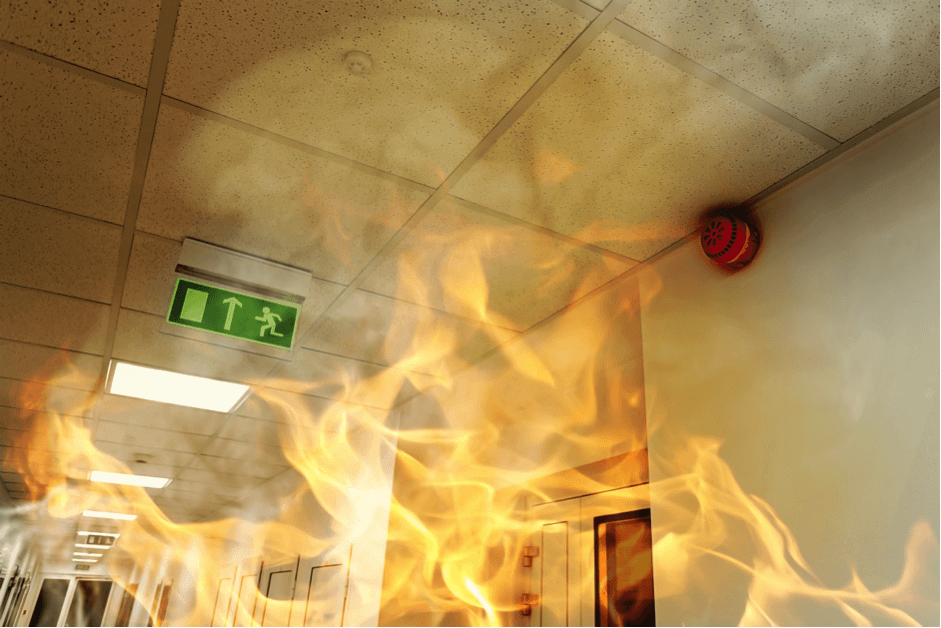Who is the responsible person for completing fire risk assessments?
The UK government’s “Fire safety in the workplace” website states that all business owners are responsible for the fire safety within their premises. However, it also states that if you are an employer, owner, landlord, occupier, or have any control over the premises (e.g facilities manager or building manager) then you also have the duty to look after people’s safety within your premise.
Achieving this means conducting fire risk assessments – not just as a one off, but on a regular basis. The person carrying out the fire risk assessment will typically be a manager, facilities manager, building manager or a professional fire risk assessor.
It’s also important to take note that if you have shared premises, this means that there can be multiple people responsible for completing the fire risk assessment of those premises. This means that those multiple people will all have to take responsibility for the whole building, and not just the areas of the building they are using.
For business owners, it is recommended to conduct a fire risk assessment annually, as most businesses will continually have guests and staff going in and out of the premises. With a business such as a bed & breakfast, care home, hotel, or self-catering property, it’s important to take in all unique aspects, and ensure provisions are in place for staff and guests even at times of low occupancy.
A fire risk assessment is not only essential for the safety of the business; it also puts a secure plan in place to ensure customers and staff are safe in case of a fire. We recommend using an experienced fire risk accessor so you can be sure that your premises are as safe as they can be in case of a fire emergency. Having a professional conduct a fire risk assessment will give you and your team peace of mind, as everything would be done as thoroughly as possible.
Therefore, its crucial to take note that the person carrying out the fire risk assessment does it accurately and sufficiently. The Fire Safety Order requirements state that the person carrying out the risk assessment must feel ‘suitable and sufficient’ to do so. As such, it’s recommended you use an experienced fire risk accessor so you can guarantee that that all areas of the premises have been checked to a high standard.
A fire risk assessment can take some time depending of the size of the building, and on several other factors. Aspects that may affect this include the number of floors, number of occupants, and the level of risk. The professional should always include a full report for the building upon completing the fire risk assessment.
What must you do as the responsible person?
As the responsible person of the premises, you must carry out and review assessments of the building on a regular basis. This requires that the responsible person fully understands the risks and the measures put in place to maintain a high safety standard for all people involved. Staff members and representatives must also be kept up to date with the risks and safety measures put in place to maintain their safety. As the responsible person, it is your duty to ensure these safety measures are maintained.
The responsible person must have an emergency plan in place, and must inform all staff on how to initiate and carry out the emergency plan. You can make sure staff know what to do in case of a fire by giving them appropriate, up-to-date fire safety training. This should happen regularly so that staff are aware of the risks that are found during each fire risk assessment.
What steps are included in fire risk assessment?
There are five key steps when conducting a fire risk assessment:
- Identify the fire hazards;
- Identify people at risk;
- Evaluate, remove or reduce the risks;
- Record your findings, prepare an emergency plan and provide training;
- Review and update the fire risk assessment regularly.
First and foremost is reviewing the building and identifying any potential fire hazards. These risks will be ranked from low risk to high risk. The elements we would check can be things such as flammable chemicals and substances, as well as identifying how good the plan of action is for staff and guests if there was a fire, including factors that might affect how it is carried out, such as emergency exits.
The second step is determining who is at risk. This can include people that work closely with those potential fire hazards, e.g. a chef working with gas. The third step included in the assessment is an emergency plan. The emergency plan will detail where staff members and guests should exit and congregate in the event of a fire. The plan will include all exit points, and will have a clear plan of where the meeting point should be. The plan should include multiple options for different scenarios, in case exit doors are blocked or obstructed.
If you have any questions, SAMS has a team of health and safety advisors that have extensive experience of conducting fire risk assessments. Completing a fire risk assessment is essential for any business, and should follow the government guidelines religiously.
If you are in in reading some of our other blogs click here ‘5 main components of a fire risk assessment’
Please contact us via live chat or email, or give us a call here.

